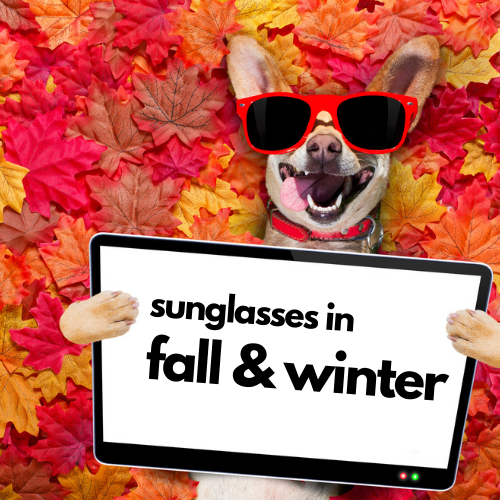Do you Need Sunglasses in the Fall and Winter?


Wearing sunglasses is typically associated with the summer, while scarfs, mittens, and boots are associated with the fall and winter seasons. It has been reported that more than 80 percent of Americans wear sunglasses in the summer, but fewer than 30% wear them in the fall and winter.
4 Reasons to Wear Sunglasses in Fall and Winter
Here are four reasons to continue wearing your sunglasses in the fall and winter:
Light Glare Reduced with Sunglasses
GLARE: In the fall and winter in the Northern Hemisphere the sun rises in the southeast and transits the celestial meridian at a low angle and then sets in the southwest. This lower angle creates more glare. Sun glare impacts your vision after exposure to it, which means that for a few seconds after encountering glare you can’t see as well. This makes combating glare a safety issue when driving.
The best way to combat glare is with polarized sunglasses. Glare is light that is reflected off of a horizontal surface that becomes a concentrated beam of light. Polarized sunglasses have a polarized coating pressed between two layers of the lens that absorbs the incoming horizontal light rays.
Ultraviolet Light Rays
UV RAYS: Harmful UV rays are still present in the fall and winter and even on those cloudy winter days. Exposure to UV rays is damaging to the eye and can cause cataracts and macular degeneration. So wearing sunglasses that are both polarized and UV blocking year round is recommended.
The Wind
WIND: The fall and winter bring lots more windy days and that wind can cause your eyes to become dry and irritated. Wearing sunglasses is a good way to protect your eyes from exposure to wind and the dust and debris that it can carry with it.
Cold Temperature
COLD: The drop in temperature causes the oil in your tear film to thicken and this leads to a stiffening of the tear film. The tear film loses some of its ability to form a continuous layer across your eye. Sunglasses can help shield your eyes from cold fall and winter winds that can cause your tear film to thicken.
If standard sunglasses seem too dark for you to wear in the fall and winter, you can get green or brown tinted lenses. There are also other tinted shades such as yellow, gray, or red. Your eye care professional can help you choose the tint that is best for you.
Gregory Scimeca, M.D.
Ophthalmologist and Medical Director
The Eye Professionals
Our Locations
